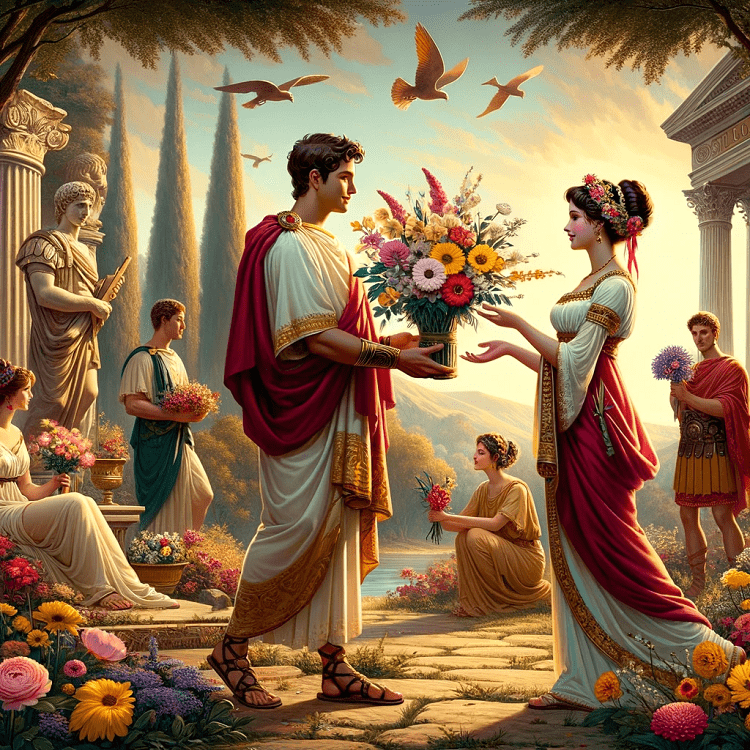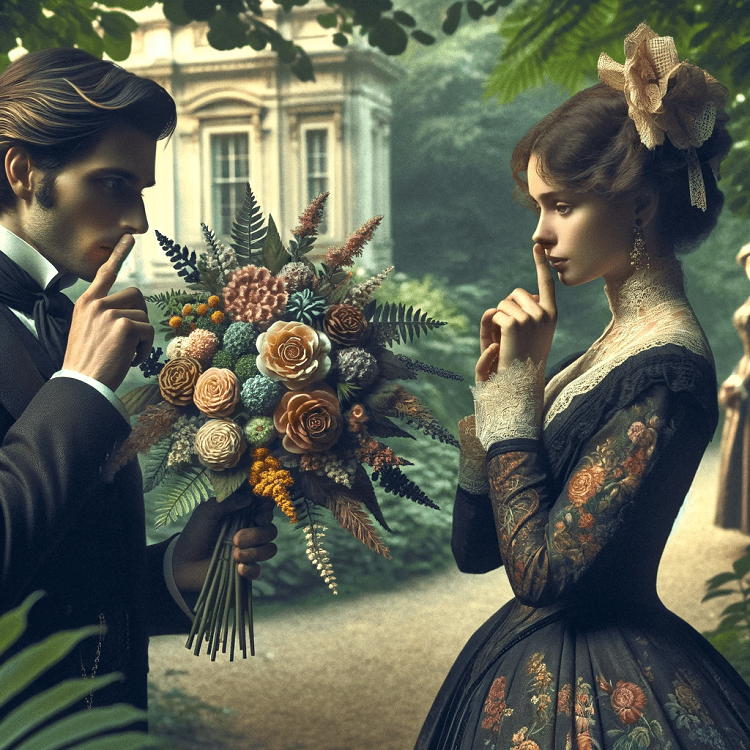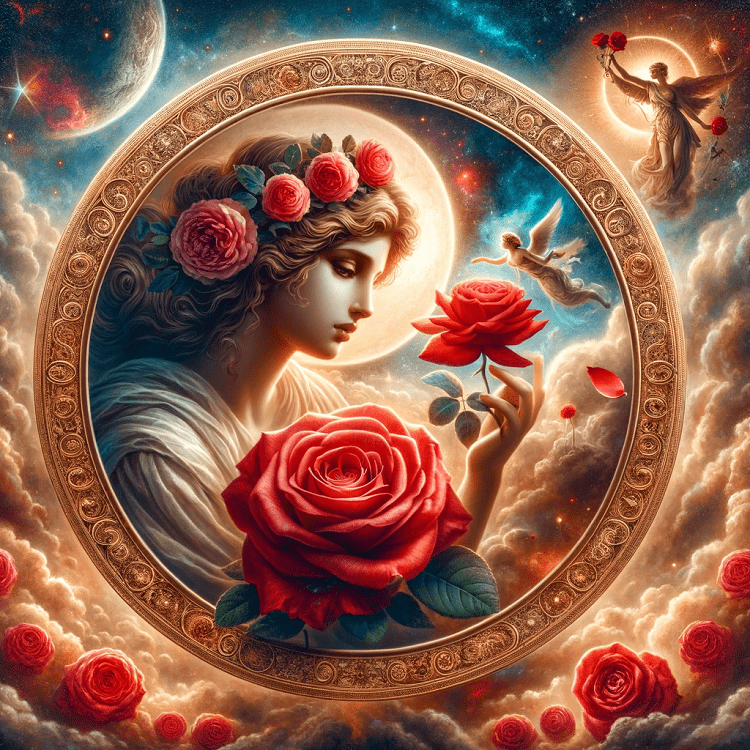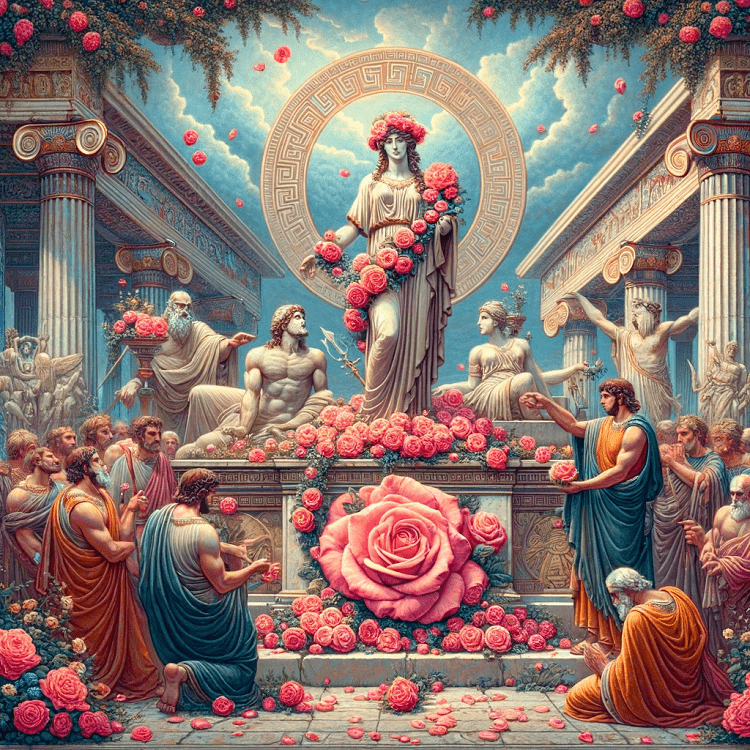From Ancient Rome to Modern Day: The History of Valentine's Day Flowers

Valentine's Day marks a time for exchanging affection through sweet words, chocolates, and notably, flowers. While the story of Saint Valentine is rich, the tradition of gifting roses has its own captivating history.
This custom of floral gifts dates back centuries, with origins in ancient civilisations and 18th century traditions. King Charles II of Sweden popularised the language of flowers, allowing covert expression of emotions improper to state publicly.
Flowers, especially roses, became symbols to convey deep affection on Valentine's Day. The red rose links to Venus, Goddess of Love, its symbolism now integral to the holiday.
In this article, we'll explore the origins of gifting blooms on this day of romance. We'll trace the background of floral arrangements as tokens of love in different cultures and time periods - from Greek and Roman mythologies, to elaborate Victorian bouquets.
Whether you're a hopeless romantic, history buff, or simply appreciate floral beauty and symbolism, join this journey through the romantic past. We'll uncover the storied role of roses and botanical expression in Valentine's Day lore.
2025 US Valentine's Spending
Average per person: $185.81
Gift-Giving Patterns
Australian Market 2023
Average per person: $118
Current Trends
The History of Valentine's Day
Valentine's Day has evolved from ancient Roman rituals into the romantic holiday we cherish today.
Its origins trace to Lupercalia, a February celebration of spring involving fertility rites and matching singles by lottery. This pagan festival was later transformed as Christianity spread through Rome.
The modern version takes its name from Saint Valentine. However, the true origins are murky as several early Christian martyrs bore the name. One account depicts a 3rd century priest who defied orders by performing banned marriages, while another describes a similar figure, Saint Valentine of Terni. Though shrouded in intrigue, these narratives feature a heroic romantic rebel.
As Christianity grew dominant, elements of Lupercalia were absorbed into the Valentine’s Day concept of courtly love. By medieval times, the day involved affection and romance rather than random matches. Traditions like cards, flowers and sweets emerged over later centuries to become hallmarks of the modern holiday.
The origins weave a compelling story, one clouded by legend but still central to this date celebrating relationships and devotion today. The rich history remains as fascinating as any grand romance.

In the 5th century, Pope Gelasius I established the February feast of Saint Valentine, aiming to Christianise the pagan Lupercalia festival. The timing of bird mating seasons reinforced this date’s link to romance.
Over the centuries, Valentine’s Day gained popularity across Europe. Literary masters like Chaucer and Shakespeare extolled courtly love in their works, cementing the holiday’s amorous connections. By the 1700s, handmade token swapping was traditional. Soon after, the 1840s saw the advent of commercial Valentine’s cards in America.
This gradual evolution transformed a fertility ritual into the celebration of affection we know today. From pagan origins to poetic romanticism to commercialisation, the history of Valentine’s Day is as multilayered as love itself.
Today, Valentine's Day is celebrated worldwide, with various traditions that include the exchange of cards, chocolates, and, of course, flowers. The red rose, in particular, has become synonymous with beauty and love, a symbol that has withstood the test of time.
As we celebrate this day devoted to love, we should reflect on the rich history that spawned the Valentine’s Day traditions we enjoy today.
The threads of this romantic tapestry stretch back to raucous pagan rituals in ancient Rome, through whispered tales of a defiant saint secretly marrying couples. Over centuries, stories and customs entwined to shape the holiday marked across the globe with cards, chocolate and affection.
Valentine's enduring charms weave together drama and devotion - from fertility festivals where singles were paired by chance, to a tenacious priest risking wrath to perform banned marriage rites. Even persecution could not suppress the resilience of love praised each year on February fourteenth.
This day commemorates not just passion, but the perseverance of the human spirit in pursuing bonds despite daunting odds. As we open candy boxes and love notes, we continue that legacy Valentine began.
The Tradition of Giving Flowers on Valentine's Day
The custom of floral tributes on this date emerged in the 1700s, reportedly spread by King Charles II of Sweden following his Persian travels. Here he learned the intricate language of flowers, or floriography, used to subtly signal emotions too provocative to state directly.
This coded botanical messaging enabled romantic communication to flourish. On Valentine’s Day specifically, bouquets became symbols of affection. Every flower carries meaning, but red roses epitomise passion. Their ties to Venus, Goddess of Love secure them as the quintessential expression of ardor on February fourteenth.

Though styles and trends shift, flowers remain the steadfast messengers of romance. Blooms that once silently signaled forbidden love now boldly declare public displays of admiration. Regardless of era or culture, floral gifts continue to symbolise what the heart dares to utter at this singular moment for professing devotion.
The Victorian era saw flower gifting refined into an intricate art, with bouquets conveying complex encrypted messages. Each bloom and arrangement held secret meanings, enabling coded communication between lovers. This focus on floral symbolism continues to influence modern Valentine’s Day tributes.
Today, presenting flowers on February fourteenth has become a global phenomenon, with millions of bouquets given yearly. While customs keep evolving, the sentiments persist. Be it a single rose or deluxe display, botanicals remain symbols of admiration and affection.
As we celebrate amid roses and romance, we continue a tradition that blossomed from ancient rites to convert Victorian courtships. Though styles and mores shift, the floral gifts retaining their power to express the ineffable language of love. Even in their silence, they speak volumes from the heart.
The Significance of Roses
Roses have long stood as symbols of love and devotion, especially on Valentine's Day. Their lush petals and sweet perfumes have been associated with romance across cultures for centuries. But how did these flowers become the definitive botanical emblem of affection?
Evidence of early rose cultivation stretches back over 4,000 years to ancient Chinese and Mediterranean civilisations. These blooms initially had ceremonial, medicinal and perfumery uses. As time progressed, red roses became linked to Venus, Goddess of Love, securing their reputation as tokens of ardor.

During the Victorian era, the intricate language of flowers, known as floriography, exploded in popularity. Each rose variety and color held distinct romantic meanings. Red symbolised passion, pink conveyed gentler affection, white represented purity, and yellow expressed joy.
The Language of Roses: Victorian Era Meanings
During the Victorian era, each rose color carried specific symbolic meanings, allowing people to communicate complex emotions through flowers.
Red Roses
Deep passion and romantic love; the ultimate expression of devotion and desire
Pink Roses
Gentle affection and admiration; perfect for expressing gratitude and joy
White Roses
Purity and innocence; traditionally associated with new beginnings
Yellow Roses
Friendship and cheerful emotions; symbolizes warm, platonic relationships
Today, while fads fade, red roses remain the quintessential Valentine’s Day gift, with a dozen symbolising year-round devotion. As we present our loved ones with these favors, we continue an artistic tradition that has wound through history, evoking age-old connections of beauty to the heart’s affections.
The Role of Roses in Different Cultures and Eras
Embark on a fascinating journey through time and cultures, exploring the enduring allure of roses and their significant role in history.
The role of roses in different cultures and eras is a testament to their timeless appeal and profound symbolism. From ancient civilisations to modern societies, roses have been revered for their beauty, fragrance, and symbolic meanings.
In ancient Greek and Roman cultures, roses were closely associated with the gods. The red rose, in particular, was linked to Aphrodite, or Venus as she was known in Roman mythology, the Goddess of Love. Roses were often used in religious ceremonies and to adorn statues of the gods. They were also used as confetti at celebrations, as a source of perfume, and even as a medicinal ingredient.

The Victorian era saw a heightened interest in the language of flowers, or floriography. Roses, with their myriad of colours and varieties, were central to this floral language. Each colour and type of rose held a different meaning, allowing individuals to express a range of emotions. Red roses symbolised love and respect, pink roses indicated admiration and gratitude, and yellow roses represented friendship and joy.
In the Middle East, roses have a rich history, particularly in areas like Iran, where they've been cultivated for over a thousand years. The rose gardens of Iran are legendary, and the country is known for its rose water and rose perfume.
In modern times, roses continue to play a significant role in various cultural practices and celebrations around the world. They are a popular choice for weddings, anniversaries, and of course, Valentine's Day. The red rose remains the ultimate symbol of love and affection, making it the perfect choice for Valentine's Day flowers.
As we explore the history of giving flowers on Valentine's Day, it's clear that roses, with their rich history and universal symbolism, have truly earned their title as the 'Queen of Flowers'. Whether given as a single stem or a lavish bouquet, roses continue to be a timeless expression of love.
Modern Valentine's Day Celebrations
From ancient civilisations to modern societies, roses have captivated imaginations while retaining profound symbolic power. Their lush petals and sweet perfumes trace through the rituals, myths and customs of countless cultures.
In Greek and Roman myth, roses became associated with goddesses of love and beauty like Aphrodite and Venus. These blooms adorned deities, graced ceremonies and scented the air at festivities. During the Victorian era, roses played a starring role in the intricate language of flowers, with each variety encoding distinct romantic meanings.
In addition to roses, other types of flowers, such as tulips and lilies, have also gained popularity as Valentine's Day flowers. The choice of flower often depends on personal preference, cultural practices, and the specific message the sender wishes to convey.

Regions like Iran have cultivated roses for over a millennium, producing legendary gardens, prized rose water and perfumes. In the Middle East and beyond, roses continue to feature prominently in celebrations, customs and courting rituals today.
Though civilisations rise and fall, the rose maintains its reign, becoming ever more intertwined with romance. On Valentine’s Day specifically, these flowers convey the depths of emotion that words cannot aptly capture. From a single bud to a dozen, roses remain symbols of beauty and devotion, as resonant now as in antiquity.
Further Reading
If you've enjoyed learning about the history and significance of giving flowers on Valentine's Day, you might also be interested in discovering how to make those beautiful blooms last longer. In another article on our blog, titled "4 Ways to Preserve Your Valentine’s Day Flowers", we explore various methods to preserve and cherish your Valentine's Day flowers for a longer time. From pressing to drying, each technique allows you to extend the life of your flowers, keeping the memories of that special day alive. So, after you've given or received your Valentine's Day bouquet, why not try preserving those blooms? You'll not only have a lasting memento of Valentine's Day, but also a beautiful piece of natural art to display in your home. Or, you can view our entire category of Valentine's Day posts here.
Summing Up...
From ancient civilizations to today, flowers have conveyed amorous sentiments across eras. The tradition of gifting blooms flourished amongst Greek and Roman festivals adorned with roses honoring Venus, Goddess of Love. Victorians cultivated an intricate floral vocabulary, with every flower and hue encoded with meaning.
Though cultures and customs shift, florals persist as tokens of affection. On Valentine’s Day specifically, the red rose retains its long-held ties to romance and passion. This custom spans over two millennia, continuing traditions of courtship rooted in antiquity.
Now, amidst modern commercialization, these messages from the heart endure, binding us to rich histories of romantic communication. Though much changes, love finds its familiar conduits - from goddess-graced buds to social media posts with rose emojis. Tokens transform, but the sentiments inscribed upon petals passed between hands remain unwaveringly human.
So this year, alongside cards and confections, cherish the perseverance of affection expressed through blossoms. Despite dating’s dizzying revolutions, flowers still decipher the heart’s ageless words and rhythms when all else fades.
This article was originally posted on 30.12.25. We gave it some love and posted again on 29.1.25. By love we mean like fully rewritten and add some cute visualisations.
